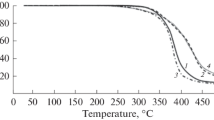Summary
Epoxy resins derived from epichlorohydrin and Bisphenol-A have been converted into air-drying varnishes by cooking with vegetable oils. Compared to varnishes derived from ordinary varnish resins, the epoxy resin-oil varnishes have faster bodying rate, higher viscosity, lighter color, and lower acid number. Although the epoxy resin-oil varnishes dry slowly and yield soft films like many other soft oil varnishes, they have remarkably good exterior durability in clear films upon wood, and in pigmented films have good chalk resistance. The varnishes are quite different from epoxy esters derived from epoxy resins and fatty acids. These latter products dry rapidly and yield hard, flexible films possessing good abrasion and chemical resistance.
In cooking the varnishes at the high temperatures (580°F.) employed, epoxy groups are destroyed and the total hydroxyl content remains essentially unchanged. At lower temperatures (480°F.) the alcoholysis of oils by the hydroxyl groups in the epoxy resin proceeds readily while the epoxy groups remain essentially intact. Such alcoholyzed products may be used for further cooking with acids of various types. Phthalic anhydride, for example, was used to convert the product to an alkyd having good drying properties.
Similar content being viewed by others
References
Greenlee, S. O., U. S. Patents 2,456,408 (1948), 2,493,486 (1950).
Hochstein, F. A., J. Am. Chem. Soc.,71, 305 (1949).
Jungnickel, J., Peters, E., Polgar, A., and Weiss, F., “Organic Analysis,” vol. I, p. 127 Interscience Publishers, New York, 1953.
Renfrew, M. M., Wittcoff, H., Floyd, D. E. and Glaser, D. W., ACS Division of Paint, Plastics, and Printing Ink Chemistry Preprint Booklet, vol. 14, p. 171, Kansas City, March 1954).
Scheibli, J. R. and Dannenberg, H., Offic. Dig. Federation Paint and Varnish Production Clubs, No. 330, 491 (1952).
Shell Chemical Corporation, Brochure “Epon Resins for Surface Coatings”, 1952: Paint Oil, Chem. Rev.,113, 25 (1950)
Tess, R. W., Jakob, R. H., and Bradley, T. F., Ind. Eng Chem.46, 385 (1954).
Tess, R. W., and May, C. A., Offic. Dig. Federation Paint and Varnish Production Clubs, No. 311, 1114 (1950).
Von Mikusch, J. D., and Frazier, C., Ind. Eng. Chem., Anal. Ed.,13, 782 (1941).
Author information
Authors and Affiliations
About this article
Cite this article
Tess, R.W. Oleoresinous varnishes from epoxy resins and drying oils. J Am Oil Chem Soc 32, 291–295 (1955). https://doi.org/10.1007/BF02634464
Received:
Issue Date:
DOI: https://doi.org/10.1007/BF02634464



